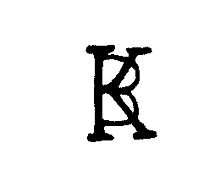Karl Ballenberger
Karl Ballenberger (born July 24, 1801 in Ansbach, then Prussian, in what is now Central Franconia ; † September 21, 1860 in the Free Imperial City of Frankfurt am Main ) was a German history painter .
Life
Ballenberger was the son of a carpenter, who visited an art school and then for a time in a porcelain factory in Bruckberg as a porcelain painter worked. In 1831 he learned the profession of stone cutter , which he practiced in Ansbach for nine years from 1822. In 1831 he went to Munich with Friedrich Hoffstadt . He learned drawing from this artist and art collector and at the same time attended the Academy of Fine Arts in Munich . He was discovered because of his achievements by the Munich Association for German Antiquity and, on its recommendation, supported by Crown Prince Ludwig with 20 guilders a month . The friendship between the Crown Prince and Ballenberger continued.

In his Munich years he was active both as a painter and as a stone carver and worked on the former Carmelite Church in Nördlingen, which was renovated in the neo-Gothic style . In the same city, a stained glass window with an Adoration of the Magi was made in the Church of the Holy Spirit .
In 1833 Ballenberger went to Frankfurt am Main with his artist colleague Hoffstadt and became a student at the Städel Art Institute , which was then headed by Philipp Veit . His main subject of study was oil painting, which he pursued from then on in a historical-romantic sense. His technique was based on role models such as Albrecht Dürer or Martin Schongauer . He gave his first oil painting from Frankfurt am Main St. Georg defeating the dragon that holds the king's daughter prisoner to the Association for German Antiquity . He made other work for furnishing the Kaisersaal in Frankfurt's Römer . These were representations of emperors and kings from German history and were donated by various people or institutions. These were firstly on behalf of the Städel Konrad I , secondly on behalf of King Ludwig I Ludwig of Bavaria , as the third picture Moritz von Bethmann donated a portrait of the anti-king Günther von Schwarzburg and finally commissioned a Bavarian association on the initiative of the Bavarian ambassador in Frankfurt Bundestag Arnold Friedrich von Mieg a picture of King Ruprecht for the imperial hall.
In the following years he made a large number of historical representations, which were created as oil paintings on canvas or wood, as well as watercolors or engravings.
Ballenberger died in Frankfurt am Main. His grave is in the main cemetery there in Gewann F 470.
literature
- Ernst Kelchner: Ballenberger, Karl . In: Allgemeine Deutsche Biographie (ADB). Volume 2, Duncker & Humblot, Leipzig 1875, p. 21 f.
Web links
Individual evidence
| personal data | |
|---|---|
| SURNAME | Ballenberger, Karl |
| BRIEF DESCRIPTION | German history painter |
| DATE OF BIRTH | July 24, 1801 |
| PLACE OF BIRTH | Ansbach |
| DATE OF DEATH | September 21, 1860 |
| Place of death | Frankfurt am Main |
